Nets replace shotguns when banders search for the brown-mottled bird with the long bill.
By Bob Gwizdz
The bird, sitting dead still under a fallen tree trunk, is safe from Schultz's weapon of choice this day--a long-handled landing net, seemingly more appropriate for bass fishing than bird hunting.
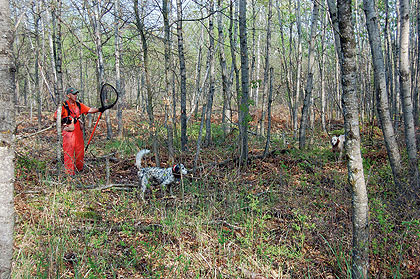 Where's the shotgun? It's at home, as Jerrie Schultz, a woodcock banding volunteer, carries a net to capture woodcock for banding during the spring nesting season. |
But for Schultz, the thought that he won't be able to get his net over the hiding hen is only of minor consequence as the bird's stubborn refusal to flush tells him there's a bigger prize to be found: a brood of woodcock chicks.
Schultz is one of about 100 Michigan bird hunters who enjoy pursuing woodcock two seasons of the year--the 45 days in the autumn when they take to the early successional forests with their shotguns and pointing dogs and the slightly more than month-long season in the spring when they leave the scatterguns at home and go out with landing nets and pliers.
Woodcock Banding
Schultz is a woodcock bander, one of a group who get at least as much of a kick out of catch-and-release woodcock hunting in spring as they do shooting at the needle-nosed migrants in fall. The object to fasten small, metal, numbered bands around the chicks' legs and let them go.
A retired automotive engineer from Frankenmuth (not far from Saginaw), Schultz spends 25 days or more each spring pursuing the birds with his setters. In a good year, he'll band 100 of the young chicks, though, like most of his banding buddies, he doesn't like to talk about numbers. Numbers, he says, are not the point.
Schultz has been banding woodcock for a dozen years, something he started after seeing a television program about the activity and becoming immediately intrigued with the pastime.
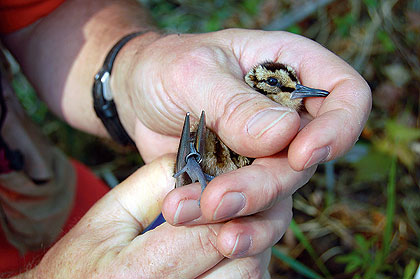 Once a volunteer finds and captures a brood of woodcock, he attaches a numbered band to each chick's leg. |
"It looked like not only so much fun, but such wonderful dog work," said Schultz, who has hunted behind English setters for 25 years. "From the time I first got a pointing dog, I ran them religiously up 'til the 15th of April (when most birds are breeding and hunters may not take their dogs afield in Michigan). I found out there was a seminar [about banding] so I signed up."
Schultz didn't get a permit to band birds immediately; he was required by the Department of Natural Resources to spend a year's apprenticeship under an experienced bander to learn the ropes. And he was also required to prove that his dog was completely under control when afield.
"I got my dog approved and the next year I started on my own," he remembers.
Ignoring the hen hiding under the deadfall, Schultz peers at the brown spring grass, looking for any signs of movement or something that doesn't look quite right. And when he sees what he's looking for--a woodcock chick--he drops a ribbon and continues the search.
It takes eagle eyes; the young brown and tan birds blend perfectly into the dead grass. But Schultz stays with it until he thinks he's found all the chicks he's going to find (usually four, the typical brood, but sometimes fewer). Then he retraces his steps, picking up the young birds he's located and putting them in a mesh bag until he's ready to go to work.
The process doesn't take long. First he measures the chick's bill--"A woodcock hatches with a 14-millimeter bill and it grows two millimeters a day," he explains--to determine how old the bird is. Then he attaches a band to the bird's leg, records the number on it (as well as the length of the bird's beak) in a notebook and places the bird in another mesh bag until he has handled all the chicks.
When he's finished, Schultz builds a nest of loose grass, puts the freshly banded birds in it, covers it with another layer of dead grass, collects his dog and is on his way.
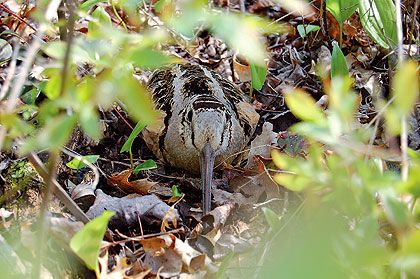 Due to the woodcock's superb camouflage, finding them in thick cover can be a challenge, even with a good gun dog. |
This time, the mother hen never leaves her safe haven below the fallen tree trunk. More often, the brooding hen will flush, but will usually only fly a short distance, going into the old broken-wing routine to try and draw the intruders away from the nesting chicks.
Generally, that short, distracting flight is the first tip-off that there are chicks nearby, Schultz says. And usually, the mother has returned to the area well before he's out of sight of the vicinity.
"Many times I've had a hen return and watch me band," he says.
Michigan leads North America in the number of woodcock banded, thanks to the volunteers the state's Department of Natural Resources permits to band birds. Band returns provide biologists with information on migrating routes and wintering grounds, answering questions about the mysterious birds--which are in the midst of a long-term population decline.
"This is the largest chick-banding operation, certainly in this country, and potentially in the world," says Al Stewart, the upland game bird biologist at Michigan's DNR and himself a sometimes woodcock bander.
Stewart credits the volunteers with helping Michigan become one of the preeminent woodcock research sites in the world. The volunteers, who undergo a mandatory training session as well as a year-long apprenticeship, gives the DNR a virtual army of researchers working in the field.
"This has been going on since the 1960s, but it's really gained ground in the last 10 years," Stewart says. "And banders have become more efficient at banding."
In 2005, Michigan's volunteer woodcock banders spent roughly 1,600 hours afield, banding 689 chicks, Stewart said. Volunteers reported seeing 75.8 chicks and banding 54.2 of them per 100 hours afield.
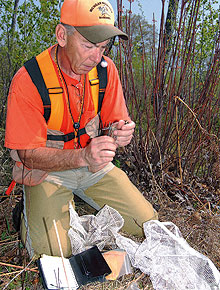 After banding the woodcock chicks, Jerrie returns them to nesting cover. |
So what happened to the other 21.6 chicks that weren't banded? They flew away.
It doesn't take the birds long, generally about two weeks, before they're mature enough to fly. So banders generally get started early in the spring; peak hatch (defined as when half the young of the year have hatched) generally occurs around April 27 in the southern third of the state, May 2 in the more northerly stretches.
Greg Hortze, a 55-year-old UPS driver who has been banding woodcock for 27 years, takes three weeks of vacation--half of his annual leave; he takes the other half during hunting season--during May, gradually working his way north banding woodcock.
"It's my passion," he says. "If I had to choose between hunting and banding, it would be banding without a doubt. To be able to do something for wildlife and still be able to use your pointing dogs is just great."
Hortze starts close to his southern Michigan home and eventually works his way up to the northeast corner of the Lower Peninsula, where he pitches a tent and camps out with his English setters.
Hortze guesses he spends 80 to 100 hours banding woodcock, though he doesn't start his time clock until he finds his first brood, he said. Keeping track of how much time they spend is important to some banders as every year the DNR gives an award to the bander with the most hours spent on the ground banding.
It didn't always. At one time the award went to the bander who handled the most birds.
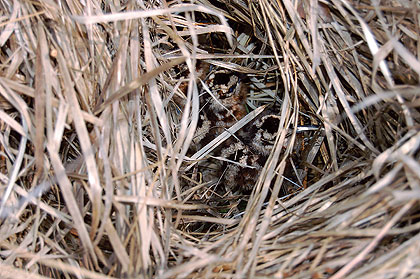 Keeping meticulous records of the number of woodcock banded is part of the passion that makes up the whole experience. |
But both the DNR and the banders agreed that wasn't the point of woodcock banding.
"It's not a contest," Stewart says.
Hortze, who banded the most birds in the state in 1992 and was named Bander of the Year for his achievement, agrees.
"It's really not a competition," he says. "We just recognize everybody who's trying to do a good job for a good cause." But most banders couldn't care less about the recognition as the actual activity is rewarding enough.
"It's my favorite thing that I do compared to hunting or fishing or anything," says Andy Nuhfer, a DNR fisheries biologist who's been banding woodcock for the last 15 years.
"The trilliums are out, the weather's beautiful and there are not a lot of other people out there, so you've got the woods practically to yourself. The dog enjoys it, you get good pictures and the little woodcock are so cute you can hardly stand it."
Nuhfer, a life-long bird hunter, got started banding when a wildlife biologist asked him to show a bander he knew some places to find birds. Nuhfer went out with the guy and got immediately hooked. "I said this is way too much fun, I've got to do this myself."
Since he's received his banding permit, Nuhfer has banded more than 700 woodcock, though he acknowledges he didn't find many his first few years.
"It's way, way harder than hunting," he said. "Your find rate is much, much lower. I've had very good dogs go right by a nest when I knew it was there. They're not moving and they're not putting out a whole lot of scent."
Schultz concurs.
"Sometimes you find broods, go back the next day and never find anything," he says.
"It's a wonder we ever find any at all, except that we're looking in the right places.
"The tough thing to learn is what's the most productive cover. We know about cuttings--that's easy. But there's a whole lot more productive ground than just cuttings."
Openings are important, too. It's typical to find broods on the edge of the thick stuff, not far from a two track or pipeline or other opening. Over the course of the day I spent with Schultz, his dogs located three broods consisting of two, three and four chicks. Banding any bird is a good day, he said. Banding nine is a very good day.
"Yesterday 10 miles from here I found two broods and they both flew off on me," he says. In contrast, the three broods we found were, according to their bill measurements, merely days old."
Like many woodcock banders, Schultz says spring woodcock season is even better than fall.
"I get more of a kick out of banding than hunting," he says. "It's a lot easier to shoot a woodcock than find a brood. The dog work has to be flawless and then you've got to find them. But if I had to choose one or the other, I'd take banding.
"I still hunt them and enjoy it," he continues. "It doesn't bother me to shoot them, other than the two or three times I've banded a chick in the spring and killed it in the fall.
"That's a little weird."
Nuhfer thinks it's more than a little weird.
"Once in a while I shoot a banded bird and I feel terrible," he says. "It's like shooting one of your kids."






